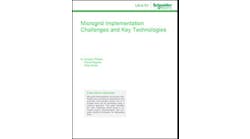U.S. Department of Energy Funds Clean Energy Microgrids in Rural and Remote Communities
Another wave of money from the Bipartisan Infrastructure Law has been released by the U.S. Department of Energy (DOE) as it commits $366 million for up to 17 clean energy projects that will impact communities in 20 states and 30 tribal areas.
The funding is from the Energy Improvements in Rural or Remote Areas (ERA) program, which is managed by the DOE’s Office of Clean Energy Demonstrations.
The selected projects will employ a variety of clean energy technologies, including solar, battery energy storage systems, hydropower and microgrids. Some of them span multiple states and tribal communities.
Multiple health care microgrid projects funded by the DOE
The CHARGE Partnership plans to use the more than $57 million award to develop solar plus storage microgrids at rural community health centers, the first of which will be installed in Tunica, Mississippi. The microgrid will provide energy reliability to the facility, ensuring continuity of care during emergencies.
The system will power emergency room operations, refrigeration for vaccines and other life-saving medications, as well as medical devices during outages. It is expected that as many as 175 health centers in Alabama, Florida, Georgia, Kentucky, North Carolina, South Carolina and Tennessee will receive similar systems thanks to the ERA funds.
According to a statement from the DOE, participating health care facilities may save upwards of $45 million in energy costs.
Tribal nations receive funds for microgrid projects
In northern Wisconsin, the state’s Office of Sustainability and Clean Energy (OSCE) proposal would see the $9.78 million award used to deploy 23 microgrid systems on Red Cliff Band Tribal lands and in Bayfield county. The OSCE will also assist with workforce development programs in an effort to increase permanent employment in the area.
Also in Wisconsin, the Bad River Band of Lake Superior Tribe of Chippewa Indians were selected to receive more than $14 million to create the Mashkiiziibii minigrid, which will improve energy resilience and reduce energy costs.
The Microgrids for Community Affordability, Resilience, and Energy Decarbonization (CARED) project was selected to receive $45.3 million to develop solar plus battery storage microgrids in seven rural communities, including the Shakopee Mdewakanton Sioux community.
Other microgrid projects funded
The Iowa State University Electric Power Research Center proposal would use its $9.5 million award to increase energy resilience for rural communities and to create a new community college renewable microgrid curriculum to provide education and training for the local workforce.
Finally, the Fort Lupton microgrid project in Colorado was selected to receive $6.12 million for a microgrid, floating solar array and battery storage system.
Funds support energy equity
In support of President Biden’s agenda to ensure renewable energy equity, all the projects selected to receive ERA program funds are either in, or near disadvantaged communities.
At least 12 of the 17 projects will support tribal communities, which are often remote.
According to a 2023 report from DOE’s Office of Indian Energy, nearly a quarter of Navajo Nation homes and 35% of Hopi Indian Tribe homes are not electrified. Of the homes in those communities with electricity, more than a third face outages each month.
The winning projects will also assist other low income and disadvantaged communities. The vast majority of impoverished counties in the US are in rural areas. Those residents typically spend a higher percentage of their income on energy bills than other households – often up to three times more according to a statement from the DOE.
The microgrids, as well as other solar plus storage projects funded by the ERA, aim to improve access, reliability and reduce energy costs for these communities.








